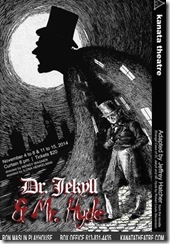The Strange Case of Doctor Jekyll and Mr. Hyde: An Evening of Potent Imagery and Fine Ensemble Acting.
Poster for Kanata Theatre
American playwright Jeffrey Hatcher has created an astonishing new stage version of Robert Louis Stevenson’s The Strange Case Of Doctor Jekyll And Mr. Hyde. It astonishes because of the way it refines and deepens Stevenson’s preoccupation with the idea of a dual nature lurking within every human being, also because of its audacity in offering its own spin on what happens when the respected Henry Jekyll’s lab experiments turn him into the homicidal, cane-wielding Mr. Hyde.
The original novel remains a creepy read. And Kanata Theatre’s sterling production of Hatcher’s play ensures a similar frisson. Director Wendy Wagner, assisted here by Ilona Henkelman, shrouds this piece in atmosphere. Skeletal images lurk behind the fog and gloom, and even the play’s brightly lit moments seem imprisoned in an impenetrable darkness. The existence of creatures and things that go bump in the night seems entirely plausible.
So yes, this is a mood piece. But at Kanata it also moves with a bracing energy and offers a bouquet of fine ensemble acting.
Six performers — Nick Chronnell, Aaron Lajeunesse, Emily Walsh, Paul Behncke, Tracey Nash and Gordon Walls — are on view in 22 roles, with each of these characters neatly and persuasively defined in this production. But the script’s big innovation is to require four of them, including one woman, to play Mr. Hyde.
Jeffrey Hatcher didn’t want his stage adaptation to examine the nature of good and evil in purely black and white terms. By his own admission, he wanted to offer “variations” on this theme. So Dr. Jekyll, convincingly portrayed by Nick Chronnell in this Kanata production, is not the purest of the pure, not a total exemplar of goodness. He can be arrogant and self-absorbed, dangerously in denial over the consequences of his experiments with the soul, convinced to the point of delusion that he can triumph over Mr. Hyde.
But, of course, he can’t triumph — a point ruthlessly hammered home, thanks to rampaging presence of the four Hydes, representing different sinister elements of Jekyll’s subconscious — and, by implication of his true nature — that his folly has unleashed.
So Jekyll’s demonic creation is there to torment him in a multiplicity of identities. And unlike the film versions in which Fredric March and Spencer Tracy played both Jekyll and Hyde, Hatcher’s version allows them to confront each other and interact with each other before our eyes. There’s a ferocity tinged with desperation in the performance of Aaron LaJeunesse as perhaps the most terrifying of the Hydes, but this is but one of the occasions when you ask yourself how many fractured psyches are really on display here.
Hatcher’s adaptation, glistening with intelligence and inventiveness, also finds a genuine erotic component in the story. As he has pointed out in an interview, sexuality was absent in the Stevenson novel — indeed he argues that the women get short shrift. But it was certainly present in Rouben Mamoulian’s 1932 film version in which March’s grotesque and frightening Hyde lures good-time girl Miriam Hopkins into his clutches. And in Kanata’s production we have Emily Walsh, brilliant as the chambermaid Elizabeth Jelkes, confronted by a creepy Hyde’s seductive powers. Walsh, an actress seemingly capable of inhabiting any character she plays, is the stand-out in this production, but there’s a solid craftsmanship in all the performances — Tracey Nash moving confidently through the potential shoals thrown up by a female Hyde, Paul Behncke giving his own unsettling spin to one of literature’s most famous boogeyman, Gordon Walls displaying a chameleon adaptability in no less than six characterizations.
But Kanata’s Jekyll and Hyde is not only an ensemble triumph. It’s also a visual achievement. Maxine Ball’s costumes not only show a sense of period, contributing in particular to Emily Walsh’s powerful stage presence, but when necessary they make their own contribution to the eeriness of this piece. The outfitting of the four Mr. Hydes — blackness with slashes of scarlet — carries its own unearthly quiver.
The play’s scenes unfold swiftly without sacrifice of tension. And always, looming up somewhere on stage is an ominous red door suggesting a portal into the unspeakable. The door is the most omnipresent component of Karl Wagner’s design which seems to be inviting us into a black hole of the spirit. Taking a leaf from Tanya Moiseiwitch’s famous design for Stratford’s Festival Theatre, Wagner has also created a multi-levelled set on which the inhabitants of the play can further seek to work out their destinies. Wagner, in his additional capacity as lighting designer, has ensured that there are times when it will all be swallowed up by the surrounding darkness. And this contributes further to an evening of potent imagery.
Dr. Jekyll And Mr. Hyde
Adapted by Jeffrey Hatcher from the Robert Louis Stevenson story
A production of Kanata Theatre
Director: Wendy Wagner
Assistant Director: Ilona Henkelman
Set Design and Lighting: Karl Wagner
Costumes: Maxine Ball
Music: Rob Mitchell
